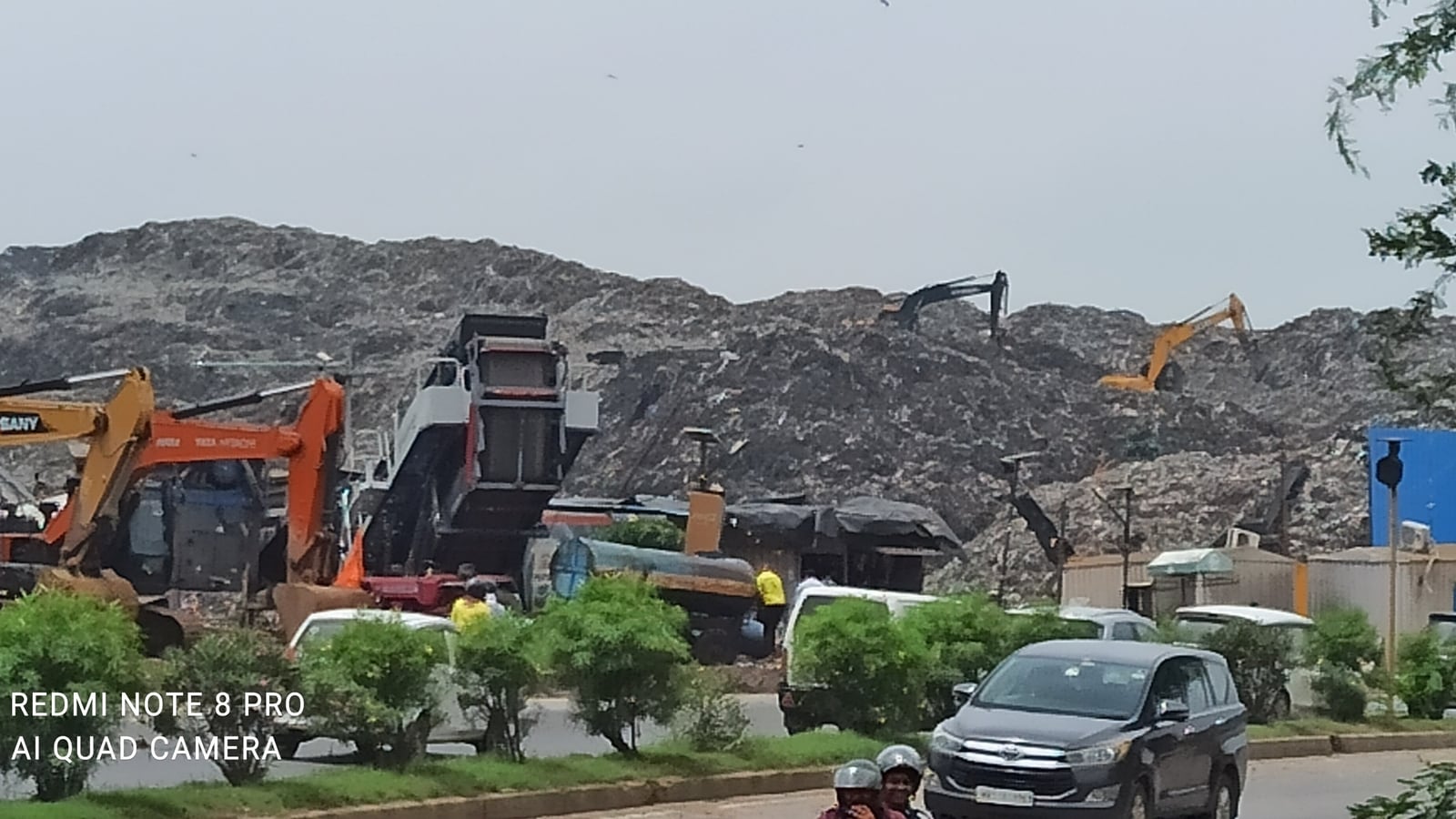Just beyond Gurugram’s shimmering skyline dotted with luxury condominiums, golf courses and bustling commercial centres lies a stark reminder of the city’s neglected underbelly: the Bandhwari landfill.
 Gurugram’s Bandhwari landfill has grown into a major environmental crisis, impacting nearby villages and upscale residential areas alike. (Parvesh Sharma)
Gurugram’s Bandhwari landfill has grown into a major environmental crisis, impacting nearby villages and upscale residential areas alike. (Parvesh Sharma)
Situated along the Gurugram-Faridabad Road, this 30-acre dumping ground has become a towering symbol of environmental neglect, poor governance, and the mounting cost of urbanisation.
Once a relatively untouched area near the ecologically sensitive Aravalli range, Bandhwari today is a colossal 37-metre-high garbage mountain. With over 1,600 tonnes of mixed waste arriving daily — 1,000 tonnes from Gurugram and 600 from Faridabad — the landfill is now regarded as one of the biggest environmental and public health threats in the region.
From urban glamour to mountain of waste
The journey to Bandhwari begins on the modern Gurugram-Faridabad Road, which connects two of Haryana’s largest industrial cities. Lined with upscale residences, this stretch ends in an alarming contrast — a landfill that chokes the air and clogs hopes for future development.
Established in 2010, the Bandhwari landfill was meant to be a scientific waste management site. Instead, it has devolved into a dumping ground where only 600-650 tonnes of waste are treated daily, while the rest piles up, emitting toxic fumes and contaminated water into nearby soil and water systems.
Residents living in the landfill’s shadow
The ripple effects of this mismanagement are being felt and endured far beyond the site. Villages such as Bandhwari, Baliyawas, and Gwal Pahari — along with premium housing societies including Ansal Valley View Estate, Paras Quartier, Suncity Vatsal Valley, and Ballioner Residences — are caught up in the toxic air and poisoned groundwater of Bandhwari village which have brought along an alarming rise in health problems.
Also Read: Is Gurugram’s luxury real estate boom sustainable? Experts weigh in on price and demand trends
“Before this dumping yard came up, the air was clean. Now, the smell is unbearable, and people are falling sick,” said Mahipal, a local villager.
Nihal, another resident, described how even livestock haven’t been spared. “The groundwater smells foul. Many people have been diagnosed with cancer. Our cattle are dying,” he said grimly.
Real estate hit hard
Beyond health hazards, the landfill has also become a major deterrent to real estate development. Areas once projected to be thriving urban hubs are now stalled by environmental red flags. Residents of even distant housing complexes complain about the fires at the landfill that blanket entire neighbourhoods in thick, toxic smoke.
“Our society is a few kilometres away from the landfill, but visible from our terrace. When it catches fire, we suffer from extreme air pollution,” said Varun Kalra, a resident of Ansal Valley View Estate.
The landfill’s overflow onto the Gurugram-Faridabad Road is another concern. Garbage occasionally spills onto the 4-lane road, causing commuting hazards and diminishing the area’s appeal for both investors and residents.
A daily struggle for labourers
The landfill’s visual assault is being hastily hidden behind a large metal shed being erected along the roadside. A team of 15 labourers, many without basic safety gear, are racing to complete the job under harsh conditions.
“Working here is very difficult,” said Harsh, a minor among the group. “But we have no other choice. We need to earn our livelihood.” The shed may hide the garbage from passing vehicles, but it does little to mask the harsh realities faced by those forced to work and live in its proximity.
Promises vs. reality
In 2023, the National Green Tribunal imposed a ₹100 crore fine on the Haryana government for its failure to manage the Bandhwari site. This triggered renewed commitments, with Urban Local Bodies Minister Vipul Goel promising better landfill management.
However, progress remains slow. Of the 2 million tonnes of legacy waste targeted for treatment by June 2025, only half has been processed so far. Meanwhile, the Municipal Corporation of Gurugram continues to dump fresh waste daily, even as basic systems like door-to-door collection and waste segregation remain inadequate.
Environmentalists have voiced strong objections to the proposed waste-to-energy model. “Burning waste in an already polluted region like Gurugram will only make things worse,” warned Nishant Verma, a local environmentalist. Instead, he advocates for decentralised waste segregation at the source, which could reduce the landfill load by up to 80%.
Political promises and public disillusionment
The Bandhwari landfill falls under the Sohna Assembly constituency, a Bharatiya Janata Party (BJP) stronghold for the past three terms. While promises of reform abound, meaningful action has been largely absent.
In a recent attempt to pacify public anger, the state floated a ₹96 lakh tender for the beautification of the landfill’s frontage. Yet, critics argue this cosmetic fix does little to address the deeper, structural flaws in the waste management system.
A crisis waiting to explode
Experts believe that unless waste segregation becomes a household priority, and systemic changes are brought to waste processing, the Bandhwari crisis will continue to deepen.
For now, the garbage mountain grows, leaching toxins into the earth and air, a daily reminder that Gurugram’s glittering exterior hides a festering, neglected core.
Parvesh Sharma is a journalist with over 15 years of experience covering real estate, infrastructure, and a wide range of civic and developmental beats in Gurugram.
